A lifejacket is one of the most important pieces of safety equipment on your vessel and wearing one can save your life.
We recommend you wear a lifejacket at all times when on board a vessel.
Lifejacket clinics
Find out how to maintain and service your lifejackets at our make a difference lifejackets clinics.
Lifejacket requirements
Registrable vessels smaller than 4.8 metres
Registrable vessels are vessels, including sailing vessels, that are or can be propelled by mechanical power.
In protected waters
When operating a registrable vessel in rivers, lakes, dams, estuaries, harbours and waters within 400 metres from the shore, you must carry a lifejacket (Level 100 or higher) for each person on board.
In unprotected waters
When operating more than 400 metres from shore in the ocean in unprotected waters, everyone on board must wear a lifejacket (level 100 or higher).
Registrable vessels 4.8 metres or larger
Registrable vessels are all vessels, including sailing vessels, that are or can be propelled by mechanical power.
In protected waters
When operating a registrable vessel in rivers, lakes, dams, estuaries, harbours and waters within 400 metres from the shore in the ocean in unprotected waters, you must carry a lifejacket (Level 100 or higher) for each person on board.
In unprotected waters
When operating beyond 400 metres from shore in unprotected waters:
- You must carry a lifejacket (Level 100 or higher) for each person on board.
- Children aged 1 to 12 years on board must wear a lifejacket (Level 100 or higher).
Personal water craft (PWC)
All people on board a personal water craft must wear a lifejacket (minimum level 50s) at all times, in all waters.
Non-registrable vessels
Non-registrable vessels include sailboards, kiteboards, windsurfers, paddle craft, tenders and sailing dinghies.
In protected waters
When operating in protected waters it is recommended that lifejackets are worn (minimum Level 50S) by all people on board.
It is recommended that enough lifejackets (minimum Level 50S) are carried for the number of passengers on board.
In unprotected waters
When operating more than 400 metres from shore in the ocean in unprotected waters, everyone on board must wear a lifejacket (minimum Level 50S) if the craft is less than 4.8m in length.
Find out more about what safety equipment you need.
Along with the lifejacket requirements, we recommend that you also wear a lifejacket:
- at the first sign of bad weather
- at night or during restricted visibility
- when operating in unfamiliar waters
- when operating with a following sea
- when boating alone (this is especially recommended)
- if you are a poor swimmer.
Types of lifejacket
Level 100, 150, 275
Approved for use in unprotected waters.
Standard: AS 4758 or ISO 12402: level 275, level 150, level 100.
Level 100 and higher lifejackets provide a high level of buoyancy and are:
- fitted with head and neck support.
- designed to keep you in a face up floating position.
- manufactured using high-visibility colours.
- suitable for offshore and general boating in all waters.
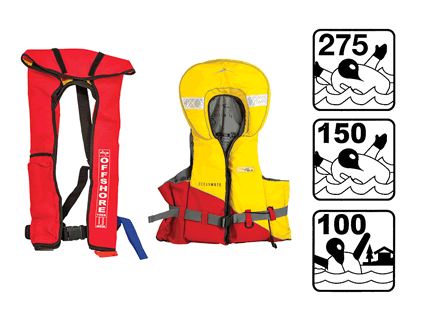
Level 50
Not approved for general use in unprotected waters (except for personal watercrafts operating within 400 metres of the shore, paddlecraft, sailboards and kitesurfers)
Standard: AS 4758 or ISO 12402 - level 50.
Level 50 lifejackets have a lower level of buoyancy than the Level 100 and higher lifejackets and are:
- not fitted with head and neck support
- not designed to keep you in a face up floating position
- manufactured using high-visibility colours
- normally used for sailing, kayaking, canoeing, wind surfing and on personal water craft.
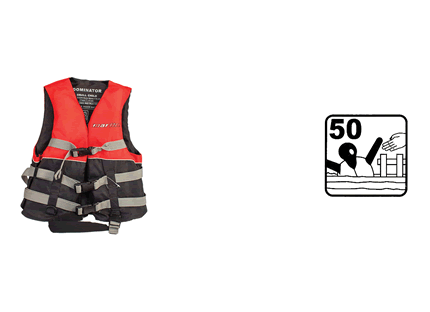
Level 50S
Not approved for general use in unprotected waters (except for personal watercrafts operating within 400 metres of the shore, paddlecraft, sailboards and kitesurfers.)
Standard: AS 4758 or ISO 12402 - level 50S.
Level 50S lifejackets have similar buoyancy to the Level 50 lifejackets and are:
- not fitted with head and neck support
- not designed to keep you in a face up floating position
- not manufactured using high-visibility colours
- favoured by waterskiers, wakeboarders, kayakers and canoeists
- available as a built in garment (e.g. water skiing wet suit).
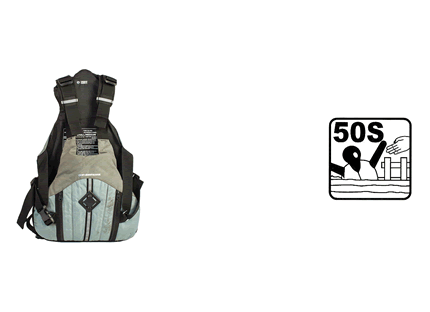
Choosing a lifejacket
When buying a lifejacket:
- try the lifejacket on before you buy to make sure it fits snugly without confining or riding up
- choose the appropriate weight and size range
- ensure you can put it on quickly, with minimal instruction
- choose one that is made in bright colours and reflective tape which will help rescuers to find you at night
- record the date of purchase on the service label if you are purchasing an inflatable lifejacket.
Babies
It can be difficult to find a lifejacket that properly fits a baby, DoT recommends that babies are not taken out on the water.
Children
When choosing a lifejacket for a child aged 1 to 12 years, make sure:
- the weight range of the lifejacket is appropriate with the child's weight
- the lifejacket is a snug fit as loose lifejackets work poorly
- the child is comfortable while wearing it
Personal flotation device standard
Australian Standard 4758 or ISO 12402 has a rating system for personal flotation devices.
Lifejackets made to the standards Australian Standards 1512, Australian Standard 1499 and Australian Standard 2260 are still acceptable for use as long as they are in good condition.
How the standard compares with older types
| Older types | Comparison to Standard AS 4758 / ISO 12402 |
|---|---|
|
Coastal lifejacket |
Level 275 |
|
PFD type 1 |
Level 275 |
|
PFD type 2 |
Level 50 |
|
PFD type 3 |
Level 50 special purpose |
Lifejacket recall
Halkey-Roberts Corporation have issued a product safety recall on lifejacket brands ‘Life Jacket Solutions’ and ‘Marlin’ with inflators stamped ‘V96000’ (manufacture date between 4 June 2001 and 15 April 2024). Refer to Product Safety Recall - Lifejackets notice for more information.
Inflatable lifejackets
Inflatable lifejackets are becoming increasingly popular. These CO2 inflated garments are lighter, more versatile and less cumbersome than conventional foam lifejackets. They can also be made as wet weather jackets and windproof vests.
When purchasing an inflatable jacket make sure it conforms with Australian Standards AS 4758 or ISO 12402- level 100 (or higher).
This will be clearly marked on the lifejacket.
Self check your inflatable lifejackets
It is important that inflatable lifejackets are serviced regularly.
Step 1
- Check for visible signs of wear and damage.
- Ensure all fastenings and buckles are in good working order.
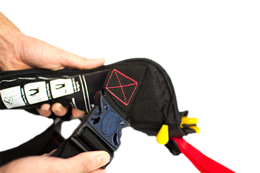
Step 2
- Following the manufacturer's instructions, reveal the inflation system and oral inflation tube.
- Inflate the bladder using the oral tube and leave overnight in a room with a constant temperature.
- If the bladder loses pressure, immediately take the jacket to an accredited service agent for further tests.
- Do not attempt to repair the jacket yourself.
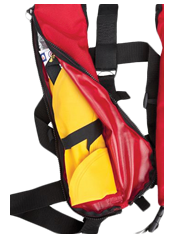
Step 3
- Use the cap attached to the oral inflation tube to deflate the bladder.
- Invert the cap and press down on the valve at the top of the oral tube.
- Do not insert other objects into top of tube as they may damage the valve.
- Roll or press jacket to deflate fully.
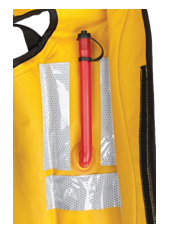
Step 4
- Remove CO2 cylinder and inspect. The cylinder should be intact with no rust or corrosion.
- Weigh the cylinder on kitchen or letter scales, ensure weight corresponds to the minimum gross weight engraved on cylinder +/- 2g.
- If the cylinder is rusted, corroded, has been pierced or is not the correct weight it should be replaced immediately. On auto inflation jackets also ensure the auto components are armed and in date. Refit the cylinder to inflation system, tightening it by hand until firm.
- Do not over tighten.
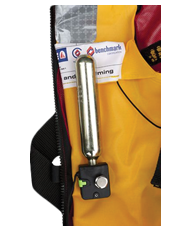
Step 5
- Record the date of maintenance on the service label of the lifejacket.
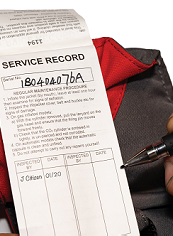
Step 6
- Repack jacket as per manufacturer's instructions.
- Ensure manual inflation toggle is accessible and unlikely to be caught when being worn.
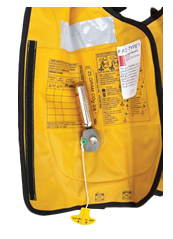
Lifejacket maintenance
You should check the condition of your lifejackets annually or as recommended by the manufacturer.
- Check for cuts and tears that could let water enter the jacket and rot the buoyant material.
- Check that the straps and buckles are in good condition and not frayed.
- Rinse with fresh water if it gets wet during use, dry prior to storage.
Find out more about maintaining your lifejacket at our Make a difference lifejacket clinics.
Lifejacket portal
You can register your lifejacket with the ANZBEG (the Australia New Zealand Safe Boating Education Group) When you register your lifejacket, you will receive servicing tips and reminders.